
Gawain, also known in many other forms and spellings, is a character in Arthurian legend, in which he is King Arthur's nephew and a Knight of the Round Table. The prototype of Gawain is mentioned under the name Gwalchmei in the earliest Welsh sources. He has subsequently appeared in many Arthurian stories in Welsh, Latin, French, English, Scottish, Dutch, German, Spanish, and Italian, notably as the protagonist of the Middle English poem Sir Gawain and the Green Knight. Other tales featuring Gawain as the central character include De Ortu Waluuanii, Diu Crône, Ywain and Gawain, Golagros and Gawane, Sir Gawain and the Carle of Carlisle, L'âtre périlleux, La Mule sans frein, La Vengeance Raguidel, Le Chevalier à l'épée, The Awntyrs off Arthure, The Greene Knight, and The Weddynge of Syr Gawen and Dame Ragnell.
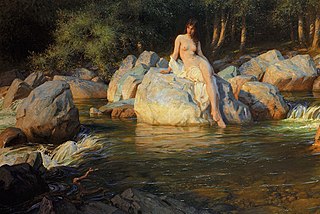
A kelpie, or water kelpie, is a shape-shifting spirit inhabiting lochs in Scottish folklore. It is usually described as a black horse-like creature, able to adopt human form. Some accounts state that the kelpie retains its hooves when appearing as a human, leading to its association with the Christian idea of Satan as alluded to by Robert Burns in his 1786 poem "Address to the Devil".

A cockatrice is a mythical beast, essentially a two-legged dragon, wyvern, or serpent-like creature with a rooster's head. Described by Laurence Breiner as "an ornament in the drama and poetry of the Elizabethans", it was featured prominently in English thought and myth for centuries.

An imp is a European mythological being similar to a fairy or demon, frequently described in folklore and superstition. The word may perhaps derive from the term ympe, used to denote a young grafted tree.
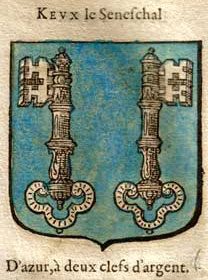
In Arthurian legend, Sir Kay is King Arthur's foster brother and later seneschal, as well as one of the first Knights of the Round Table. In later literature he is known for his acid tongue and bullying, boorish behaviour, but in earlier accounts he was one of Arthur's premier warriors. Along with Bedivere, with whom he is frequently associated, Kay is one of the earliest characters associated with Arthur. Kay's father is called Ector in later literature, but the Welsh accounts name him as Cynyr Ceinfarfog.
The Afanc is a lake monster from Welsh mythology. Its exact description varies; it is described variously as resembling a crocodile, beaver or dwarf-like creature, or a platypus and is sometimes said to be a demon. The lake in which it dwells also varies; it is variously said to live in Llyn Llion, Llyn Barfog, near Brynberian Bridge or in Llyn yr Afanc, a lake near Betws-y-coed that was named after the creature.
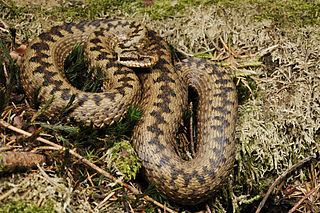
Vipera berus, also known as the common European adder and the common European viper, is a species of venomous snake in the family Viperidae. The species is extremely widespread and can be found throughout most of Central Europe and Eastern Europe, and as far as East Asia. There are three recognised subspecies.

Welsh mythology consists of both folk traditions developed in Wales, and traditions developed by the Celtic Britons elsewhere before the end of the first millennium. As in most of the predominantly oral societies Celtic mythology and history were recorded orally by specialists such as druids. This oral record has been lost or altered as a result of outside contact and invasion over the years. Much of this altered mythology and history is preserved in medieval Welsh manuscripts, which include the Red Book of Hergest, the White Book of Rhydderch, the Book of Aneirin and the Book of Taliesin. Other works connected to Welsh mythology include the ninth-century Latin historical compilation Historia Brittonum and Geoffrey of Monmouth's twelfth-century Latin chronicle Historia Regum Britanniae, as well as later folklore, such as the materials collected in The Welsh Fairy Book by William Jenkyn Thomas (1908).

The Welsh Dragon is a heraldic symbol that represents Wales and appears on the national flag of Wales.
A snake-stone, also known as a viper's stone, snake's pearl, black stone, serpent-stone, or nagamani is an animal bone or stone used as folk medicine for snake bite in Africa, South America, India and Asia.
Libeaus Desconus is a 14th-century Middle English version of the popular "Fair Unknown" story. Its author is thought to be Thomas Chestre. The story matter displays strong parallels to that of Renaut de Beaujeu's Le Bel Inconnu; both versions describe the adventures of Gingalain, the son of King Arthur's knight Gawain and a fay who raises him ignorant of his parentage and his name. As a young man, he visits Arthur's court to be knighted, and receives his nickname; in this case Sir Libeaus Desconus, before setting forth on a series of adventures which consolidate his new position in society. He eventually discovers who is his father, and marries a powerful lady.
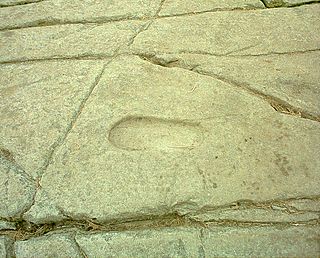
A petrosomatoglyph is a supposed image of parts of a human or animal body in rock. They occur all over the world, often functioning as an important form of symbolism, used in religious and secular ceremonies, such as the crowning of kings. Some are regarded as artefacts linked to saints or culture heroes.
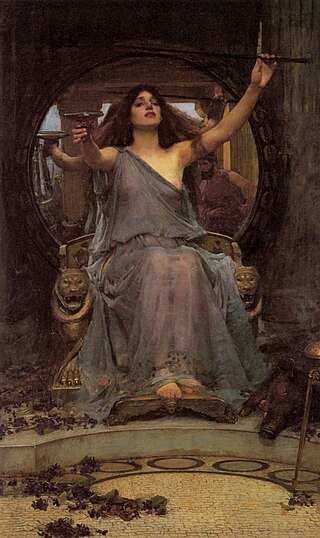
In classical antiquity, including the Hellenistic world of ancient Greece and ancient Rome, historians and archaeologists view the public and private rituals associated with religion as part of everyday life. Examples of this phenomenon are found in the various state and cult temples, Jewish synagogues, and churches. These were important hubs for ancient peoples, representing a connection between the heavenly realms and the earthly planes. This context of magic has become an academic study, especially in the last twenty years.

A touch piece is a coin or medal believed to cure disease, bring good luck, influence people's behaviour, carry out a specific practical action, etc.
A rock-cut basin is a natural cylindrical depression cut into stream or river beds, often filled with water. Such plucked-bedrock pits are created by kolks; powerful vortices within the water currents which spin small boulders around, eroding out these rock basins by their abrasive action. These basins are frequently found in streams and rivers with a relatively soft rock substrates such as limestones and sandstones. The rather unusual and man-made appearance of such depressions has led to various folk-tales becoming associated with them, such as their identification as petrosomatoglyphs, including knee prints, elbow prints, etc. of saints, heroes, kings or supernatural beings.
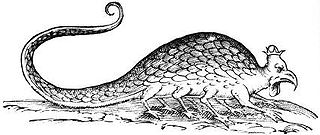
In European bestiaries and legends, a basilisk is a legendary reptile reputed to be a serpent king, who causes death to those who look into its eyes. According to the Naturalis Historia of Pliny the Elder, the basilisk of Cyrene is a small snake, "being not more than twelve inches in length", that is so venomous, it leaves a wide trail of deadly venom in its wake, and its gaze is likewise lethal.

A brownie or broonie (Scots), also known as a brùnaidh or gruagach, is a household spirit or Hobgoblin from Scottish folklore that is said to come out at night while the owners of the house are asleep and perform various chores and farming tasks. The human owners of the house must leave a bowl of milk or cream or some other offering for the brownie, usually by the hearth. Brownies are described as easily offended and will leave their homes forever if they feel they have been insulted or in any way taken advantage of. Brownies are characteristically mischievous and are often said to punish or pull pranks on lazy servants. If angered, they are sometimes said to turn malicious, like boggarts.

Caer Bran Hill Fort is an archaeological site near Sancreed and Carn Euny Iron Age village, on the Penwith peninsula in Cornwall.
Magic in Anglo-Saxon England refers to the belief and practice of magic by the Anglo-Saxons between the fifth and eleventh centuries AD in Early Mediaeval England. In this period, magical practices were used for a variety of reasons, but from the available evidence it appears that they were predominantly used for healing ailments and creating amulets, although it is apparent that at times they were also used to curse.
The nine sorceresses or nine sisters are a recurring element in Arthurian legend in variants of the popular nine maidens theme from world mythologies. Their most important appearances are in Geoffrey of Monmouth's introduction of Avalon and the character that would later become Morgan le Fay, and as the central motif of Peredur's story in the Peredur son of Efrawg part of the Mabinogion.














